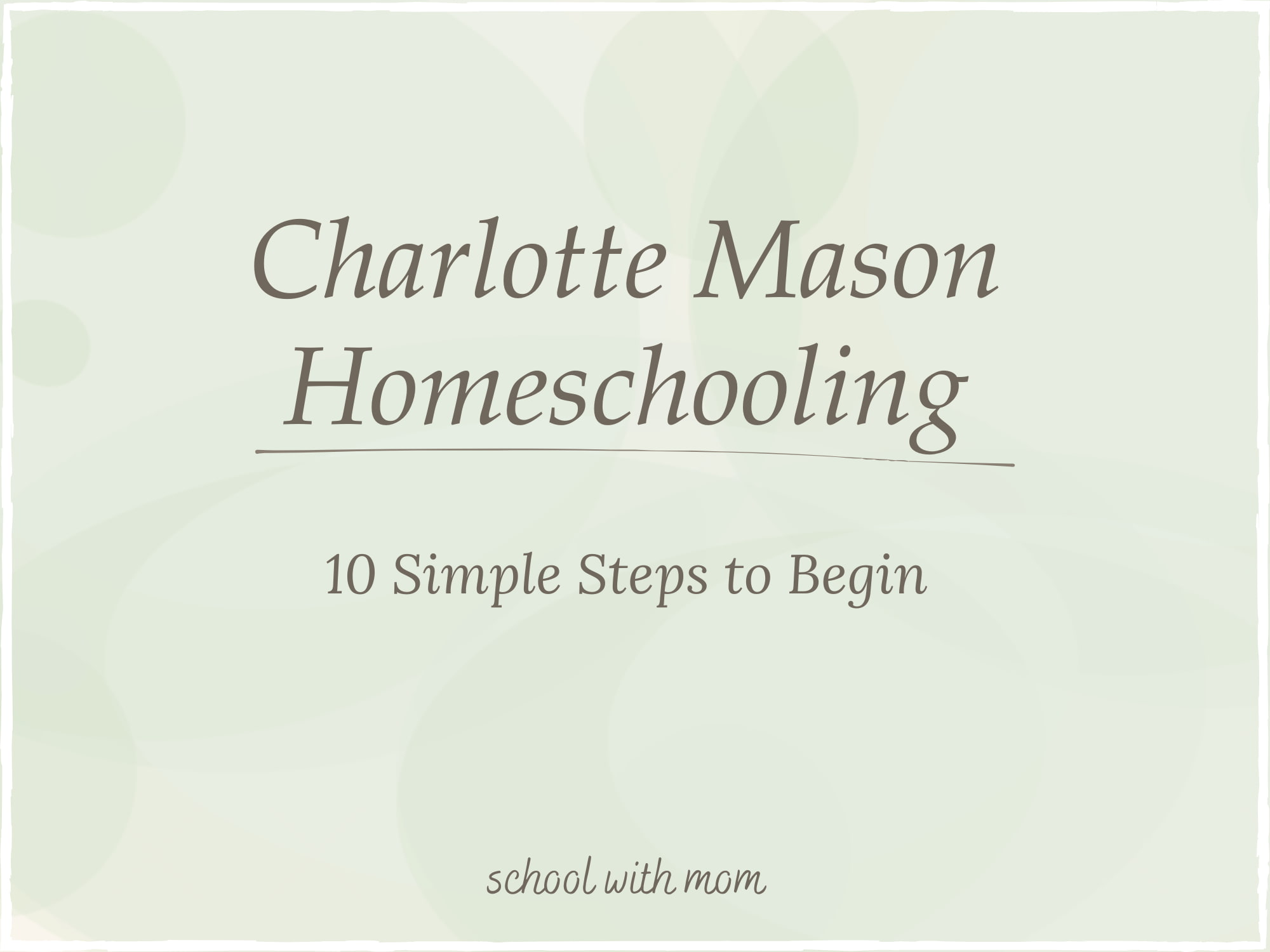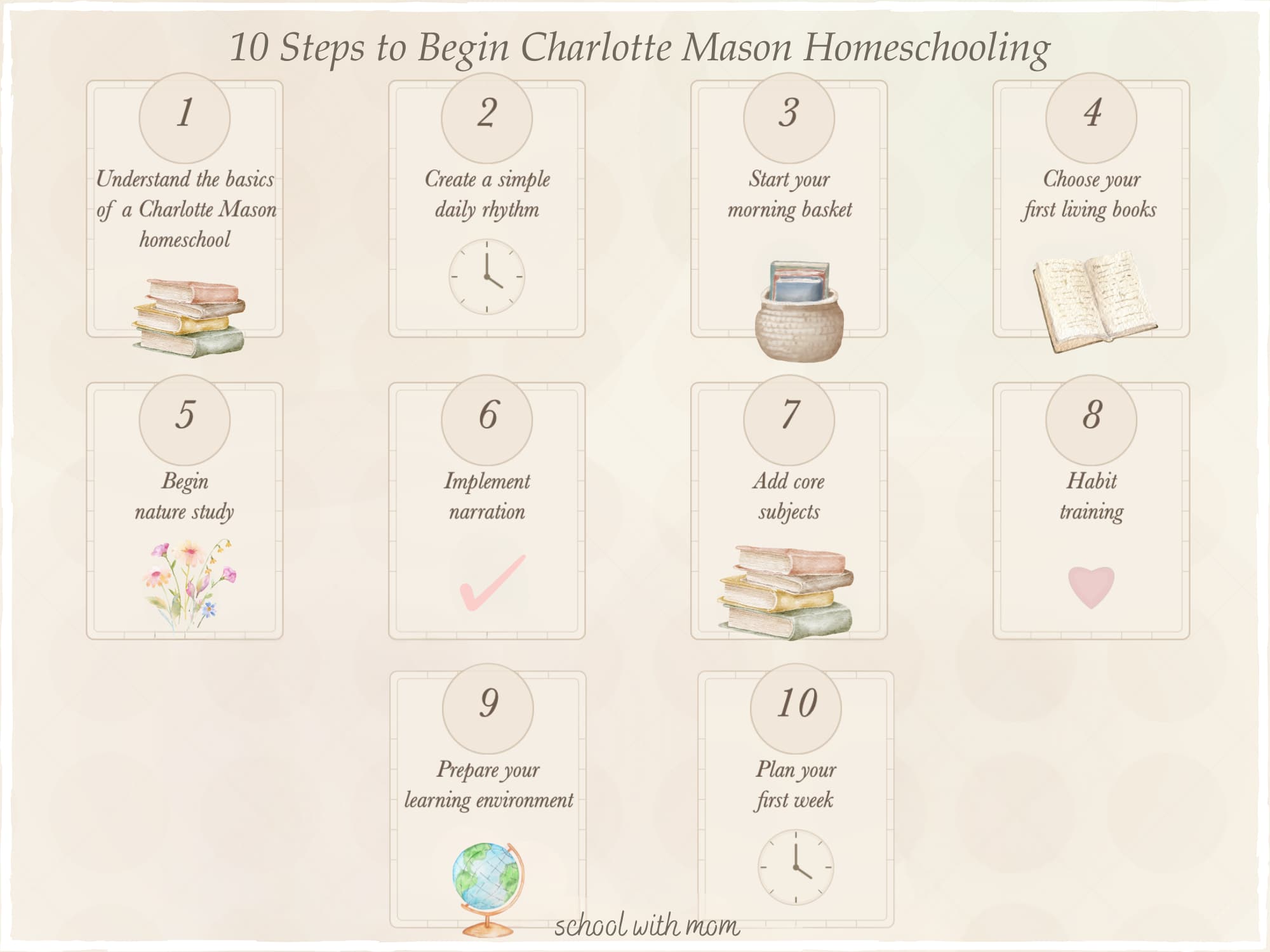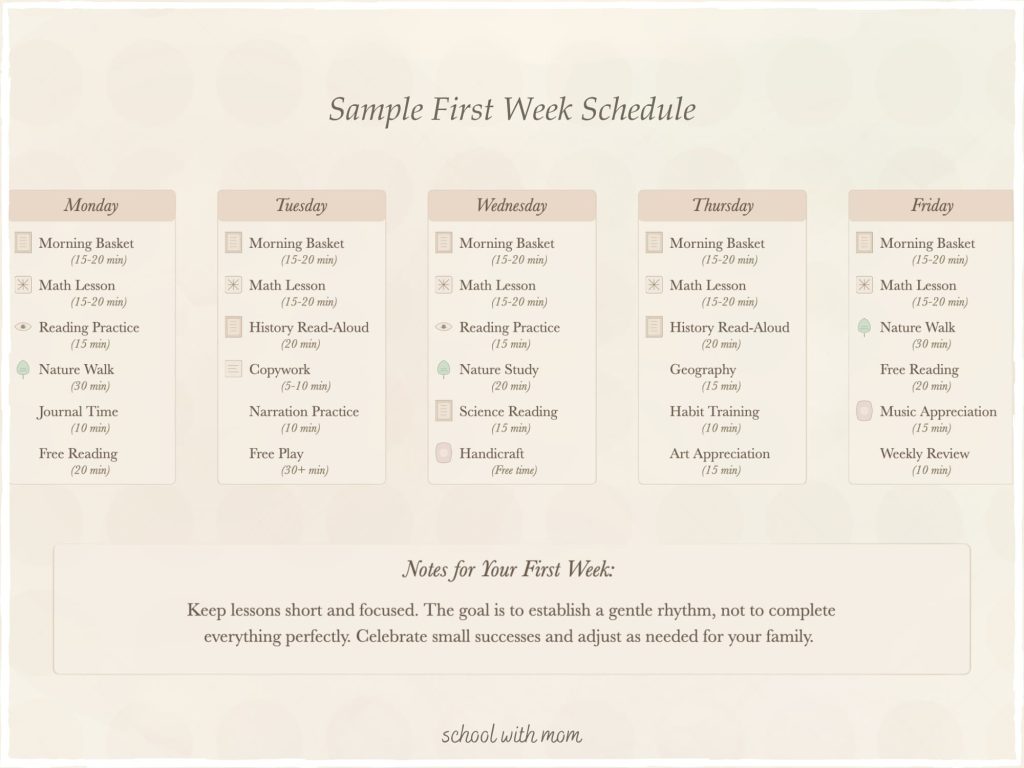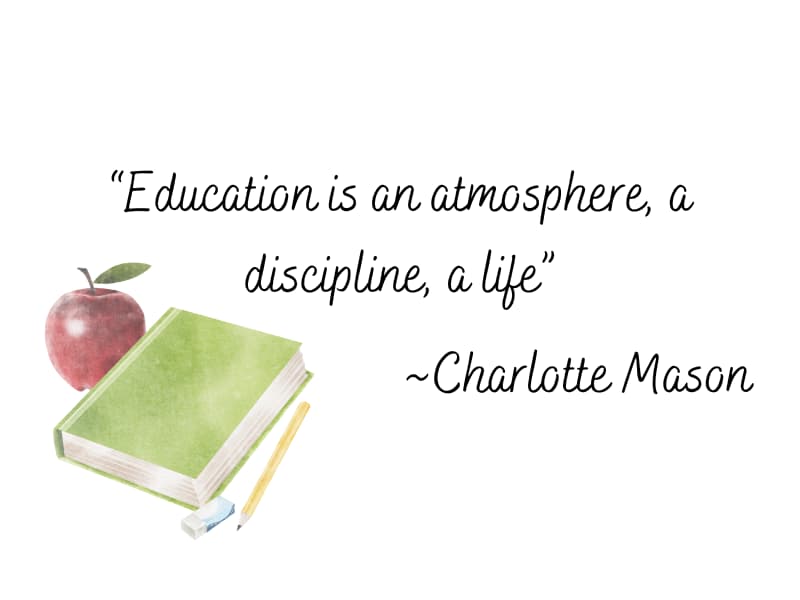Charlotte Mason Made Easy: 10 Steps to Get Started

Starting on a Charlotte Mason homeschool journey can feel both exciting and overwhelming. The Charlotte Mason method offers a rich, yet gentle, living education centered around nurturing a child’s mind, heart, and character, but knowing exactly where to begin can be challenging.
When my family first discovered Charlotte Mason’s philosophy six years ago, we were drawn to her emphasis on living books, nature study, and habit formation. The approach resonated deeply with our values, but implementing it seemed like daunting task.
Through experience, I discovered that breaking down the Charlotte Mason approach into manageable steps made all the difference. Rather than trying to implement everything all at once, focusing on one element at a time allowed us to build a strong foundation.
Within a few months, the pieces began fitting together naturally, creating a rhythm that worked for perfectly for my family and homeschool.
Below, you’ll find the exact steps we took to successfully implement Charlotte Mason homeschooling in our homeschool. Whether completely new to homeschooling or transitioning from another method, these simple steps will help create a Charlotte Mason homeschool that perfectly combines both the Charlotte Mason philosophy and the unique needs of your own family.
This post may contain carefully chosen affiliate links to help support our homeschooling journey. Thank you for supporting my family through your purchases! You can read my full affiliate disclosure policy here.
Step 1: Understand the Charlotte Mason Basics

Charlotte Mason was a British educator in the late 1800s who developed an educational philosophy based on the belief that “children are born persons”. In other words they have a natural curiosity and the ability to embrace a rich feast of ideas. Her approach centers on three key principles:
The Three Pillars of Charlotte Mason Education:
- Education is an atmosphere – The environment your family creates matters deeply. This isn’t about decorating with educational posters, but rather cultivating a home where ideas are valued, curiosity is encouraged, and learning happens naturally.
- Education is a discipline – This focuses on developing good habits rather than enforcing rigid rules. In our home, intentionally working on habits like attention, thoroughness, and orderliness created a stronger foundation than constantly correcting behaviors.
- Education is a life – Children need living ideas, not dry facts. Choose books with rich language and compelling narratives over simplified textbooks, and connect your children with real-world experiences rather than worksheets.
Understanding these basics doesn’t require reading Mason’s entire six-volume series before starting (although I recommend that at some point). This overview itself is a great foundation.
✓ THIS WEEK’S ACTION STEP: Take time to reflect on these three principles and how they might look in your home. Consider how this approach might address current challenges in your homeschool.
Curious about other approaches? Discover the key differences here: Charlotte Mason vs. Montessori: Which Method is Best for Your Family? and Charlotte Mason or Waldorf: Choosing Your Homeschool Path.
Step 2: Create a Simple Daily Rhythm

A common misconception about Charlotte Mason homeschooling is that it requires an elaborate, perfectly structured schedule. In reality, Ms. Mason advocated for a balanced approach with short, focused lessons that respect your children’s natural attention spans.
Instead of a rigid hour-by-hour schedule, my family found success with a flexible daily rhythm – a predictable flow to our days that allowed for both structure and spontaneity.
Age-Appropriate Lesson Lengths:
- Ages 6-8: 15-20 minutes per subject
- Ages 9-12: 20-30 minutes per subject
- Ages 13+: 30-45 minutes per subject
Sample Charlotte Mason Daily Rhythm:
Morning:
- Begin with your morning basket (15-30 minutes)
- Tackle focused subjects when minds are fresh (2-3 short lesson periods)
Midday:
- Enjoy lunch and free play time outdoors
Afternoon:
- Lighter subjects like history read-alouds, nature study, art, or handicrafts
Evening:
- Family read-alouds and discussions
The beauty of this rhythm is its flexibility. Some days might require adjustments for appointments, field trips, or simply following an interesting rabbit trail that captures your children’s curiosity.
✓ THIS WEEK’S ACTION STEP: Sketch out a simple rhythm that might work for your family. Observe when your children are most alert and receptive to different types of learning.
For more detailed guidance, see this post on How to Make the Perfect Charlotte Mason Homeschool Schedule.
Step 3: Start Your Morning Basket

Morning basket time quickly became the heart of our Charlotte Mason homeschool day. This simple practice creates a beautiful foundation for learning together and eases everyone into the day with shared experiences.
A morning basket (sometimes called “morning time” or “morning gathering”) is essentially a collection of resources you enjoy together as a family to start your homeschool day.
It typically includes shorter read aloud and activities that expose your children to truth, goodness, and beauty in small, digestible portions.
Morning Basket Essentials:
- Poetry: One poem to read together each day or week
- Scripture or Bible reading: A short passage to reflect on
- Art appreciation: Examining one quality art print each week from the term’s chosen artist
- Music appreciation: Listening to your selected composer’s work while settling in
- A short read-aloud: Perhaps a chapter from a character-building book
The key is keeping each element brief so the entire basket remains engaging. One of my favorite aspects of morning basket time is that it works perfectly for multiple ages together, creating the perfect bonding time between all of your children.
✓ THIS WEEK’S ACTION STEP: Gather 3-5 simple items for your morning basket. You likely already have suitable books on your shelves—a children’s poetry collection, a beautifully illustrated picture book, or a book of fables.
Need morning basket inspiration? I’ve gathered all my best ideas and favorite resources here: How to Create the Perfect Charlotte Mason Morning Basket.
Step 4: Choose Your First Living Books

At the heart of every Charlotte Mason homeschool are ‘living books’ – rich, engaging books that present ideas through beautiful language and compelling narratives. These books ignite curiosity, deepen understanding, and help children form meaningful connections with what they learn.
When we first began implementing Charlotte Mason’s methods, simply swapping out the boring textbooks for living books made an immediate difference in my children’s excitement for learning.
Starter Living Books by Subject:
Literature:
History:
Science:
- Thornton Burgess animal books
- Nature books by Jim Arnosky (for younger children)
Geography:
Character Development:
The key isn’t to build an extensive library immediately (don’t worry, that will come with time…I promise) but to begin with a few excellent books that your family can enjoy together.
✓ THIS WEEK’S ACTION STEP: Select one living book for each main subject area in your homeschool.
For a deeper understanding of what makes a book “living” and extensive book lists by age and subject, explore these helpful resources: What is a Living Book? Everything You Need to Know and 40+ Classic Books Your Charlotte Mason Homeschool Needs.
Step 5: Begin Nature Study

If there’s one element that truly sets a Charlotte Mason education apart, it’s the emphasis on regular, intentional time in nature. Charlotte believed that children form a strong foundation for scientific thinking through direct observation of the natural world around them.
Nature study doesn’t need to be complicated or require any special knowledge. When we first began, we could only identify a handful of trees and birds, yet our family’s nature study quickly became everyone’s favorite part of our homeschool week.
Simple Nature Study Supplies:
- A simple nature journal (a blank sketchbook works perfectly)
- Colored pencils
- A magnifying glass for closer observation
- One basic field guide for your region
Getting Started with Nature Study:
- Choose one small area to observe weekly (a favorite spot in your backyard or in a nearby park)
- Follow one tree through the changing seasons
- Keep a weather journal with simple observations
- Look for animal tracks or animal homes
For younger children, simply being outside is enough at first. As they grow more observant, encourage them to choose one thing that interests them to draw or describe in their nature journal. Older children should regularly sketch their observations, adding labels and brief notes.
✓ THIS WEEK’S ACTION STEP: Schedule three 20-minute outdoor sessions with your children. Don’t worry about identifying everything you see – just observe and wonder together.
Looking for ways to enjoy nature year-round? Explore these simple and fun seasonal activities in Charlotte Mason Nature Study in Winter and Simple Charlotte Mason Spring Nature Study Ideas.
Step 6: Implement Narration in One Subject

Narration is the cornerstone of Charlotte Mason’s approach to learning. This simple yet powerful practice involves having your child tell back what they’ve heard, read, or experienced in their own words. It may sound like a silly thing to do, but narration develops remarkable skills in attention, comprehension, and expression.
When we first implemented narration, I was skeptical such a simple technique could be so effective. Yet after consistent practice, I was amazed at the details my children retained and the connections they made between different readings and subjects.
The Simple Narration Process:
- Read aloud a short, engaging passage from a living book only one time
- Ask your child to tell back what they remember in their own words
- Listen to your child without interrupting, even if details are out of order
Narration Tips for Beginners:
- Select a subject your child already enjoys
- Keep readings short—just a paragraph or two at first
- If your child struggles with narrating:
- Start with a familiar story they already know well
- Use prompts like “What happened first?” or “What did you find most interesting?”
- Have them draw a picture about the reading and then discuss it
✓ THIS WEEK’S ACTION STEP: Try narration with just one read-aloud session. Observe how your child responds and adjust accordingly.
Step 7: Add Core Subjects One at a Time

A common pitfall when starting Charlotte Mason homeschooling is trying to implement too many subjects at once. We learned through experience that adding subjects gradually led to more lasting success and less overwhelm than attempting a complete curriculum overhaul overnight.
Begin with just three core subjects: reading, math, and nature study. These provide a solid foundation while you and your children adjust to the Charlotte Mason approach.
Charlotte Mason Approach to Core Subjects:
Reading and Language Arts: Focus on real literature rather than reading programs with controlled vocabulary. Use copywork (copying thoughtful passages from your favorite living books) for handwriting practice and gentle exposure to grammar and spelling. Many families, including mine, love to use McGuffey Readers as a starting point – discover practical implementation ideas in How to Use McGuffey Readers: A Charlotte Mason Approach. If you are in the process of teaching a younger child to read I have found a lot of success adapting modern reading programs to align with Charlotte Mason principles, as described in How I Use All About Reading in my Charlotte Mason Homeschool.
Mathematics: Emphasize understanding concepts through real-life application and manipulatives before abstract work. Short, focused lessons with full attention are more effective than lengthy worksheets and long math drills. Use objects around your home for counting, measuring, and problem-solving to make math relevant and concrete for your child.
Science: Begin with nature study as described in Step 5. Complement these outdoor observations with living science books that help to bring nature to life. Some of my family’s favorite read-alouds include the Thornton Burgess collection and seasonal nature selections from Charlotte Mason Spring Living Books, Winter Living Books, and Fall Living Books.
History: When you’re ready to add this subject, choose narrative histories that tell stories of real people rather than lists of facts and dates. Read short passages and use narration to ensure comprehension. A Book of Centuries (a simple book labeled with the centuries) helps children place historical events in context better than traditional timelines. Consider starting with a living history book like “Our Island Story” or “A Child’s History of the World.”
Geography: Begin with your local area, exploring features of your neighborhood and region before expanding outward. Charlotte Mason used map drills and “map questions” to make geography interactive. Discover practical methods and engaging activities in How to Teach Elementary Geography like Charlotte Mason.
For each subject you add, keep these principles in mind:
- Use living books or other hands on resources whenever possible
- Keep lessons short (15-20 minutes for young children)
- Implement narration to ensure active engagement
- Focus on the quality of attention rather than the amount of work
✓ THIS WEEK’S ACTION STEP: Choose the first three subjects to implement in your homeschool. Gather the necessary resources and plan simple, short lessons for each.
Step 8: Habit Training

Charlotte Mason placed tremendous emphasis on habit formation, believing that “the habits of the child produce the character of the man.” Unlike modern education’s focus on academic skills alone, Charlotte understood that developing good habits creates the foundation for both character and learning.
Charlotte Mason advised working on just one habit at a time until it becomes established. This focused approach allows for real progress rather than scattered attention across multiple areas.
Foundational Habits to Consider:
- Attention: The ability to focus fully on a task without distraction
- Obedience: Responding promptly to direction
- Order: Keeping belongings and materials tidy
- Truthfulness: Speaking honestly in all situations
- Kindness: Treating others with consideration
- Thoroughness: Completing tasks with care
Charlotte Mason’s Habit Formation Process:
- Choose one habit to focus on for 4-6 weeks
- Explain clearly to your child what you’re working on and why it matters
- Create opportunities for success with the habit
- Offer gentle reminders before the child falls into the old pattern
- Recognize and appreciate progress, however small
For example, if you choose to work on the habit of attention, start with very short lessons (even just 2-3 minutes) requiring complete focus. Gradually increase the time as the habit strengthens. Notice and mention when your child shows good attention.
Avoid nagging or criticism when habits slip. Instead, redirect gently and create more opportunities for success. We learned that positive reinforcement builds habits much faster than pointing out failures.
✓ THIS WEEK’S ACTION STEP: Select one habit to focus on for the next month. Discuss it with your children and create a simple plan for practicing this habit daily.
Step 9: Prepare Your Learning Environment

Creating a nurturing learning environment doesn’t mean you need a dedicated schoolroom with expensive educational materials. Charlotte Mason emphasized simple, beautiful surroundings that invite curiosity and focus rather than overstimulation.
When I was first setting up my home for learning, I discovered that less is truly more. Children learn best in orderly spaces with access to quality materials, natural beauty, and room to explore.
Elements of a Charlotte Mason Learning Environment:
- A designated area for books and notebooks that children can access independently
- A table or desk space for written work that is comfortable and well-lit
- Storage solutions that make it easy to find and return materials
- Natural elements like plants, rocks, or seasonal items collected on nature walks
- Quality art reproductions at child height
- Minimal visual clutter on walls and surfaces
- Essential supplies readily available: pencils, paper, rulers, watercolors, and handicraft materials
You don’t need to create this environment all at once. Start by organizing one area of your home that will serve as your main learning space. Remove unnecessary items, arrange essential materials neatly, and add one or two beautiful elements.
Many Charlotte Mason families find that learning happens throughout their home rather than in just one room. The kitchen table might be perfect for math and written work, while the living room couch becomes the spot for reading aloud and discussion.
✓ THIS WEEK’S ACTION STEP: Set up one dedicated space for your books and materials. Focus on making this area organized, accessible, and pleasant rather than elaborate or Pinterest-perfect.
Step 10: Plan Your First Complete Week

Now that you’ve worked through the previous nine steps and have the core elements in place, it’s time to bring everything together into a cohesive first week of Charlotte Mason homeschooling.
When we planned our first Charlotte Mason week, we kept it intentionally light. This allowed room for adjustment, conversation, and the inevitable questions that arise when trying something new.
Sample First Week Schedule:
Monday:
- Morning Basket (15-20 minutes)
- Math lesson (15-20 minutes)
- Reading practice (15 minutes)
- Nature walk with journaling (30 minutes)
Tuesday:
- Morning Basket
- Math lesson
- History read-aloud with narration
- Copywork from a quality passage (5-10 minutes)
Wednesday:
- Morning Basket
- Math lesson
- Reading practice
- Nature study/science reading
- Free time for a chosen handicraft
Thursday:
- Morning Basket
- Math lesson
- History read-aloud with narration
- Geography exploration (map work or reading)
- Continue habit focus
Friday:
- Morning Basket
- Math lesson
- Nature walk
- Free reading from a chosen living book
Notice how each day follows the rhythm you created in Step 2, uses the environment you prepared in Step 9, and incorporates all the elements you’ve been gradually implementing.
✓ THIS WEEK’S ACTION STEP: Prepare your readings and materials for your first week. Make brief notes each day about what worked well and what might need adjustment.
Your Charlotte Mason Homeschool Journey: Next Steps and Resources

Starting your Charlotte Mason homeschool doesn’t have to be complicated. By following these simple ten steps, you’ve laid a solid foundation that you can build on gradually.
Focus on consistency rather than perfection. Implement each element one at a time, and don’t move on to the next until you feel ready. Most families find that trying to change everything at once leads to burnout rather than positive lasting change.
Troubleshooting Common Challenges:
- Feeling overwhelmed? Return to the basics: reading good books, spending time in nature, and establishing positive habits.
- Children resistant to narration? Try oral narration of movies or favorite stories first, then transfer to books.
- Struggling with short lessons? Use a timer and gradually build stamina.
- Having difficulty finding living books? Start with just one or two quality books per subject while you build your collection.
Resource List:
Need more specific guidance? These additional resources cover everything from living books to nature study to help you implement Charlotte Mason methods.
Curriculum Options:
- Explore this Ultimate Guide to Charlotte Mason Curriculums in a Box to find options that align with your family’s needs, and take the guess work out of lessons.
Living Books Resources:
- 40+ Classic Books Your Charlotte Mason Homeschool Needs
- What is a Living Book? Everything You Need to Know
- The Perfect Charlotte Mason Kindergarten Book List
Teaching Methods:
- Transform Your Homeschool with Charlotte Mason Notebooking
- How to Make the Perfect Charlotte Mason Homeschool Schedule
- Create the Perfect Charlotte Mason Morning Basket
Nature Study:
- Charlotte Mason Nature Study in Winter
- Simple Charlotte Mason Spring Nature Study Ideas
- 17 Best Charlotte Mason Winter Living Books for Nature Study
Getting Started:
Whether you’re just beginning or well along your Charlotte Mason journey, the goal is to provide your children with a feast of ideas through living books, nature, and thoughtful practices. Take one step at a time, and before you know it, you’ll have created a rich learning environment that perfectly combines both Charlotte Mason’s wisdom with your family’s unique needs.






